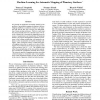Free Online Productivity Tools
i2Speak
i2Symbol
i2OCR
iTex2Img
iWeb2Print
iWeb2Shot
i2Type
iPdf2Split
iPdf2Merge
i2Bopomofo
i2Arabic
i2Style
i2Image
i2PDF
iLatex2Rtf
Sci2ools
AAAI
2007
2007
Machine Learning for Automatic Mapping of Planetary Surfaces
We describe an application of machine learning to the problem of geomorphic mapping of planetary surfaces. Mapping landforms on planetary surfaces is an important task and the first step to deepen our understanding of many geologic processes. Until now such maps have been manually drawn by a domain expert. We describe a framework to automate the mapping process by means of segmentation and classification of landscape datasets. We propose and implement a number of extensions to the existing methodology with particular emphasis on the incorporation of machine learning techniques. These extensions result in a robust and practical mapping system that we apply on six sites on Mars. Support Vector Machines show the best mapping results with an accuracy rate of ∼ 91%. The resultant maps reflect the geomorphology of the sites and have appearance reminiscent of traditional, manually drawn maps. The system is capable of mapping numerous sites using a limited training set. Immediate and eve...
Related Content
| Added | 02 Oct 2010 |
| Updated | 02 Oct 2010 |
| Type | Conference |
| Year | 2007 |
| Where | AAAI |
| Authors | Tomasz F. Stepinski, Soumya Ghosh, Ricardo Vilalta |
Comments (0)

